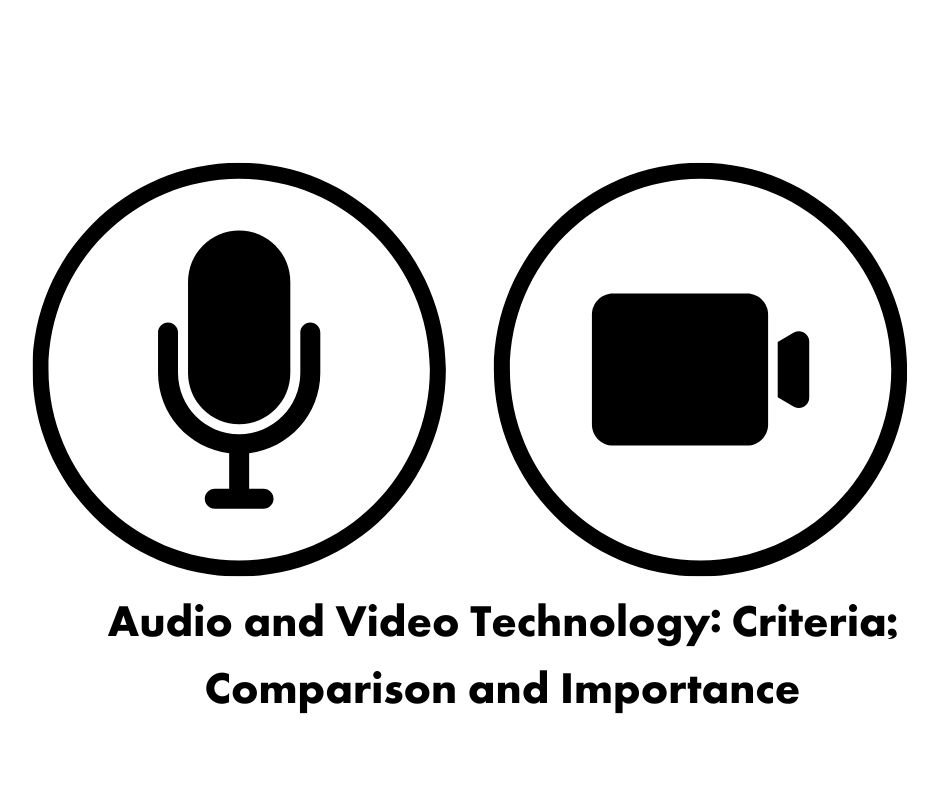Audio and video technology encompasses a diverse range of tools, systems, and methods designed to capture, process, transmit, and reproduce the essence of sound (audio) and the vivid motion of images (video). These remarkable technologies empower us to not only create but also share and immerse ourselves in the rich tapestry of multimedia experiences that shape our daily lives.

In information technology, in addition to communication technology and computer technology, information is processed using other technologies. For example, videos and camera images can be entered into the computer and processed in various ways; they can be printed accurately elsewhere via telephone, etc. Currently, computers can store information, music, pictures, and all sounds stored on compact discs.
Input →Processing →Storage→ Output
Audio and video processing are done in the same way.
| Input | Processing | Storage | Output | |
| Computer system | Keyboard etc. | CPU | Disk/Tape, RAM, CD-ROM | Monitor printer |
| Audio System | Microphone | Mixing and editing in the studio | Magnetic Tape | Amplifier Loudspeaker |
| Video System | Video Camera | Studio mixing and electronic editing | Magnetic Tape | TV set; Monitor |
Comparison of computer audio and video data processing
Criteria of Audio Video Technology
Audio Technology:
Audio technology revolves around the fascinating world of sound, involving several intricate processes:
- Capture – Utilizing sensitive microphones to record the subtle nuances of sound, from the softest whispers to powerful musical notes.
- Processing—Transforming raw audio through sophisticated software, enhancing it with effects, reducing unwanted noise, and expertly mixing tracks to create polished soundscapes.
- Storage – Archiving audio in a variety of digital formats (e.g., MP3, WAV, AAC), ensuring that these auditory treasures can be easily retrieved and enjoyed.
- Playback—bringing sound to life through speakers, headphones, or audio systems, allowing for intimate listening experiences or booming concerts in your living room.
- Transmission—Seamlessly streaming or broadcasting audio over the internet or radio waves, making music and voices accessible anywhere at any time.
Examples:
- Music production software (e.g., FL Studio, Ableton) enables creators to weave intricate musical arrangements.
- Voice assistants (e.g., Siri, Alexa) offer a touch of magic, responding to our spoken commands with ease.
- Captivating podcasts and immersive audiobooks transport listeners to new realms.
- Bluetooth speakers and earbuds deliver high-quality sound, enhancing our on-the-go listening adventures.
Video Technology:
Video technology embraces the dynamic domain of moving images, involving a series of sophisticated steps:
- Capture – Harnessing the power of cameras to immortalize moments in striking detail, from breathtaking landscapes to intimate gatherings.
- Processing—editing video content with finesse, making cuts, adding visual effects, and perfecting color grading to create mesmerizing visual narratives.
- Storage—Saving video in versatile formats such as MP4, AVI, or MOV, ensuring that these visual stories are preserved for future enjoyment.
- Playback—Showcasing videos on an array of screens, including TVs, computers, and mobile devices, bringing vibrant visuals directly into our lives.
- Transmission—broadcasting or streaming video through networks (e.g., YouTube, Zoom), connecting people across distances in real-time.
Examples:
- Video editing software (e.g., Adobe Premiere Pro, Final Cut Pro) allows filmmakers to craft compelling stories with precision and creativity.
- Video conferencing platforms (e.g., Zoom, Skype) unite individuals over vast distances, enabling virtual meetings and gatherings.
- Streaming services (e.g., Netflix, YouTube) provide an endless array of entertainment options at our fingertips.
- Smart TVs and projectors turn our living spaces into cinematic experiences, making every viewing feel like an event.
Combined Use in Real Life:
- Video Calls (Zoom, WhatsApp) blend the dual elements of audio and video, allowing us to connect with loved ones, see their faces, and hear their voices in real-time.
- Movies & TV Shows skillfully synchronize sound with visuals, crafting powerful narratives that resonate emotionally and visually.
- Online Classes leverage the power of video to engage students, combining illustrations, diagrams, and teachers’ voices for a richer learning experience.
In our world, audio and video technology is not just functional; it’s transformative, enriching our interactions and storytelling.
Importance of Audio Video Technology
Audio and video play crucial roles in computers, significantly enhancing communication, entertainment, education, and overall productivity. Let’s delve deeper into the specific reasons why they are indispensable in our digital landscape:
The Significance of Audio
1. Facilitating Communication
– Audio technology is fundamental for modern communication tools. It allows individuals to engage in voice calls and video conferencing through platforms like Zoom, Microsoft Teams, and WhatsApp. The integration of audio enables real-time dialogue, making remote collaboration more effective.
– Beyond voice conversations, advancements in speech recognition technology empower devices. Virtual assistants such as Siri, Alexa, or Google Assistant utilize audio input to interpret and respond to user commands, making everyday tasks more seamless.
2. Enhancing Entertainment Experiences
– Audio is a vital component of the entertainment sphere, powering music streaming services like Spotify and Apple Music, as well as enhancing films and games. The soundscapes created in movies or the immersive audio of video games play a pivotal role in conveying emotions and building atmosphere, enriching the viewer’s experience.
3. Promoting Accessibility
– Audio also serves a vital role in accessibility, particularly for individuals with visual impairments. Technologies like screen readers convert text to speech, providing crucial information through audio feedback and ensuring that digital content is inclusive and user-friendly.
4. Supporting Education and Learning
– In the realm of education, audio serves as a principal medium in formats such as podcasts, audiobooks, and language learning applications. These resources utilize verbal instruction to engage learners, making information more approachable and easier to absorb.
The Importance of Video
1. Enabling Visual Communication
– Video technology brings a sense of presence to remote interactions, allowing face-to-face meetings and conversations despite geographical distances. This visual aspect enhances understanding during video calls, which are instrumental in business and personal communication.
– In educational settings, video plays an essential role in presentations, tutorials, and training sessions by providing visual support that complements spoken information.
2. Central to Entertainment
– Video content forms the backbone of streaming platforms such as YouTube and Netflix, where viewers seek engaging and visually stimulating experiences. From high-quality films to dynamic gaming streams, video captures attention and drives audience engagement.
3. Enhancing Learning and Instructional Methods
– The educational landscape has transformed with the inclusion of video tutorials, online courses, and recorded lectures. These resources allow learners to grasp complex concepts more effectively by combining visual aids with spoken explanations, which cater to various learning styles.
– Visual demonstrations and simulations presented in videos allow learners to see practical applications of theoretical knowledge, making the learning process more interactive and effective.
4. Driving Marketing and Business Engagement
– In the business world, video is a powerful tool for marketing strategies. It is used for product demonstrations, advertisements, and creating engaging content to interact with customers on social media platforms. Dynamic video content can significantly boost audience engagement and brand visibility.
Audio and video functionalities transform computers from mere data-processing units into versatile tools for interaction, expression, and understanding. Together, they bridge the gap between technology and the human experience, enriching our digital interactions in countless ways.



